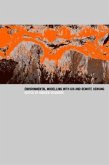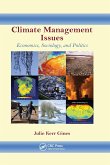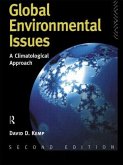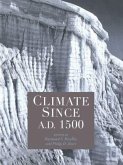Handbook of Himalayan Ecosystems and Sustainability, Two Volume Set
Herausgeber: Pandey, Arvind Chandra; Kumar, Navneet; Behera, Mukunda Dev; Parida, Bikash Ranjan
Handbook of Himalayan Ecosystems and Sustainability, Two Volume Set
Herausgeber: Pandey, Arvind Chandra; Kumar, Navneet; Behera, Mukunda Dev; Parida, Bikash Ranjan
- Broschiertes Buch
- Merkliste
- Auf die Merkliste
- Bewerten Bewerten
- Teilen
- Produkt teilen
- Produkterinnerung
- Produkterinnerung
This handbook is focused on geospatial applications used to study, assess, and monitor the Himalayan mountains. With advanced remote sensing and GIS tools, in-depth analyses, and interdisciplinary approaches, this book studies all ecosystems, anthropogenic disturbances, and climate change in the region.
Andere Kunden interessierten sich auch für
![Environmental Modelling with GIS and Remote Sensing Environmental Modelling with GIS and Remote Sensing]() Andrew Skidmore (ed.)Environmental Modelling with GIS and Remote Sensing115,99 €
Andrew Skidmore (ed.)Environmental Modelling with GIS and Remote Sensing115,99 €![Volume 1: Seabird Biodiversity and Human Activities Volume 1: Seabird Biodiversity and Human Activities]() Volume 1: Seabird Biodiversity and Human Activities89,99 €
Volume 1: Seabird Biodiversity and Human Activities89,99 €![Human Ecology and Climatic Change Human Ecology and Climatic Change]() Human Ecology and Climatic Change34,99 €
Human Ecology and Climatic Change34,99 €![Climate Management Issues Climate Management Issues]() Julie K GinesClimate Management Issues91,99 €
Julie K GinesClimate Management Issues91,99 €![Global Environmental Issues Global Environmental Issues]() David KempGlobal Environmental Issues110,99 €
David KempGlobal Environmental Issues110,99 €![The Mantle and Core The Mantle and Core]() R.W. Carlson (ed.)The Mantle and Core129,99 €
R.W. Carlson (ed.)The Mantle and Core129,99 €![Climate Since AD 1500 Climate Since AD 1500]() JonesClimate Since AD 1500153,99 €
JonesClimate Since AD 1500153,99 €-
-
-
This handbook is focused on geospatial applications used to study, assess, and monitor the Himalayan mountains. With advanced remote sensing and GIS tools, in-depth analyses, and interdisciplinary approaches, this book studies all ecosystems, anthropogenic disturbances, and climate change in the region.
Hinweis: Dieser Artikel kann nur an eine deutsche Lieferadresse ausgeliefert werden.
Hinweis: Dieser Artikel kann nur an eine deutsche Lieferadresse ausgeliefert werden.
Produktdetails
- Produktdetails
- Verlag: Taylor & Francis Ltd
- Seitenzahl: 784
- Erscheinungstermin: 13. März 2025
- Englisch
- Abmessung: 234mm x 156mm
- Gewicht: 453g
- ISBN-13: 9781032220345
- ISBN-10: 1032220341
- Artikelnr.: 73143304
- Herstellerkennzeichnung
- Libri GmbH
- Europaallee 1
- 36244 Bad Hersfeld
- gpsr@libri.de
- Verlag: Taylor & Francis Ltd
- Seitenzahl: 784
- Erscheinungstermin: 13. März 2025
- Englisch
- Abmessung: 234mm x 156mm
- Gewicht: 453g
- ISBN-13: 9781032220345
- ISBN-10: 1032220341
- Artikelnr.: 73143304
- Herstellerkennzeichnung
- Libri GmbH
- Europaallee 1
- 36244 Bad Hersfeld
- gpsr@libri.de
Bikash Ranjan Parida is an assistant professor at Central University of Jharkhand (CUJ), India since September 2016. He received his M.Sc. in Geoinformatics (2006) from the University of Twente and his PhD from the University of Hamburg/ Max Planck Institute for Meteorology (2011). Prior to joining CUJ, he was employed by various premium institutes involved in Earth and Environmental studies He has contributed to several national research projects such as Science and Engineering Research Board (SERB) under the Department of Science and Technology (DST), Start-Up Research Grant by UGC, NISAR project by SAC, Ahmedabad, ISRO. He has more than 40 research publications in peer-reviewed journals. A.C. Pandey is a professor in the Department of Geoinformatics at Central University of Jharkhand (CUJ), India. He is the former Head of the Department of Geoinformatics (2013-2020) and the former Dean of the School of Natural Resource Management (2013-2016) at CUJ. He has been the CUJ Coordinator for ISRO and EDUSAT program since 2013. From 2004-2013 he was an associate professor of Remote Sensing in Birla Institute of Technology. He received his Ph.D. degree in Geology from Department of Geology at the University of Delhi in 2001. He has published more than 70 articles and two edited books. He is the recipient of NASA-SERVIR Fellowship in 2013 to work on Himalayan glaciers in Zanskar Valley, J&K. Mukunda Dev Behera has made outstanding contributions to the fields of forest remote sensing and ecological climatology. His research innovations have fundamentally transformed the study of phytogeography, with attention to ecological functioning of three ecosystem components, plant diversity-water-energy. Dr. Behera has been a Guest Editor for six special issues and has served in three editorial boards of Springer's journals: Biodiversity and Conservation, Environmental Monitoring and Assessment, and Tropical Ecology. With over 20-year research and teaching experience, he has published over 100 articles. Navneet Kumar is a senior researcher at the Center for Development Research (ZEF), University of Bonn in Germany. He received his PhD in Engineering from the University of Bonn. His main research fields are water and natural resources management and Geoinformatics. Dr. Kumar has contributed to several projects in Algeria, Ethiopia, India, Mali, Niger and Uzbekistan. These projects include research on the impact assessment of climate change and land use change. He has presented his work in several international conferences and has published with several journals.
Introduction. Land Use and Land Cover Dynamics in Himalaya 2001 - 2020.
Shifting Cultivation Dynamics in Northeastern India. Lesser Known Unique
Ecosystems of Indian Himalayas. Spaceborne Bistatic Polarimetric
Interferometric SAR Modelling for Vegetation Height Estimation. Estimating
Aboveground Biomass of Sal and Teak Forests Using Terrasar-X and
Semi-Empirical Model. Vegetation Biophysical Parameters and GPP Estimation
Using Satellite-Driven LUE Model Urban Ecosystem and Air Pollution. Driving
Factors of Changing Rainfall Pattern in Meghalaya. Assessment of the
Effects of Land Use Land Cover Changes on Surface Temperature Trends.
Effect of Lockdown on Aerosol Optical Depth and NO2 Over Major Cities of
Indian Himalayan Region. Study on Spatial Distribution, Temporal Variation
and Growth Trends of Particulate Matter, Sulfur Dioxide, Nitrogen Oxides
and Ammonia from Anthropogenic Sources Over India. Prediction of Response
to Change in Land Use Land Cover Patterns on the Hydrology of Himalayan
River. Management Issues of Wetlands in Himalayan Foothills. Impact of
Structural Barriers on The Morphology and Ecology of The Himalayan Rivers.
Use of Satellite Remote Sensing for Water Resources Management in Data-
Scarce Watersheds. Monitoring Spatio-Temporal Glacier Dynamics and Snow
Cover Variability. Glacier Velocity Estimation Over Select Large Glaciers
in Himalaya. Rate of Expansion of Glacial Lake in Sikkim Himalayas.
Appraisal of Forest Fire Risk Through Geospatial Techniques in Uttarakhand
Himalayan Region. Disentangle the Short and Long-Term Forest Degradation
Over Most Fire Affects Parts of Western Himalaya. Identification of Flood
Hotspot Zone Using GIS-Based Spatial Statistical Technique.
Ecosystem-Human- Climate Interaction and Sustainability. Climate Forcing on
Photosynthetic Variability Across Relief Zones in Himalayas. Vegetation
Trend Analysis and Seasonal Changes Quantification Based on Time-Series
Satellite Images for North-East India. Floristic Shifting of Endemic
Species in Eastern Himalayas Due to Climate Change. Landscape Restoration
in the Indian Himalayan Region.
Shifting Cultivation Dynamics in Northeastern India. Lesser Known Unique
Ecosystems of Indian Himalayas. Spaceborne Bistatic Polarimetric
Interferometric SAR Modelling for Vegetation Height Estimation. Estimating
Aboveground Biomass of Sal and Teak Forests Using Terrasar-X and
Semi-Empirical Model. Vegetation Biophysical Parameters and GPP Estimation
Using Satellite-Driven LUE Model Urban Ecosystem and Air Pollution. Driving
Factors of Changing Rainfall Pattern in Meghalaya. Assessment of the
Effects of Land Use Land Cover Changes on Surface Temperature Trends.
Effect of Lockdown on Aerosol Optical Depth and NO2 Over Major Cities of
Indian Himalayan Region. Study on Spatial Distribution, Temporal Variation
and Growth Trends of Particulate Matter, Sulfur Dioxide, Nitrogen Oxides
and Ammonia from Anthropogenic Sources Over India. Prediction of Response
to Change in Land Use Land Cover Patterns on the Hydrology of Himalayan
River. Management Issues of Wetlands in Himalayan Foothills. Impact of
Structural Barriers on The Morphology and Ecology of The Himalayan Rivers.
Use of Satellite Remote Sensing for Water Resources Management in Data-
Scarce Watersheds. Monitoring Spatio-Temporal Glacier Dynamics and Snow
Cover Variability. Glacier Velocity Estimation Over Select Large Glaciers
in Himalaya. Rate of Expansion of Glacial Lake in Sikkim Himalayas.
Appraisal of Forest Fire Risk Through Geospatial Techniques in Uttarakhand
Himalayan Region. Disentangle the Short and Long-Term Forest Degradation
Over Most Fire Affects Parts of Western Himalaya. Identification of Flood
Hotspot Zone Using GIS-Based Spatial Statistical Technique.
Ecosystem-Human- Climate Interaction and Sustainability. Climate Forcing on
Photosynthetic Variability Across Relief Zones in Himalayas. Vegetation
Trend Analysis and Seasonal Changes Quantification Based on Time-Series
Satellite Images for North-East India. Floristic Shifting of Endemic
Species in Eastern Himalayas Due to Climate Change. Landscape Restoration
in the Indian Himalayan Region.
Introduction. Land Use and Land Cover Dynamics in Himalaya 2001 - 2020.
Shifting Cultivation Dynamics in Northeastern India. Lesser Known Unique
Ecosystems of Indian Himalayas. Spaceborne Bistatic Polarimetric
Interferometric SAR Modelling for Vegetation Height Estimation. Estimating
Aboveground Biomass of Sal and Teak Forests Using Terrasar-X and
Semi-Empirical Model. Vegetation Biophysical Parameters and GPP Estimation
Using Satellite-Driven LUE Model Urban Ecosystem and Air Pollution. Driving
Factors of Changing Rainfall Pattern in Meghalaya. Assessment of the
Effects of Land Use Land Cover Changes on Surface Temperature Trends.
Effect of Lockdown on Aerosol Optical Depth and NO2 Over Major Cities of
Indian Himalayan Region. Study on Spatial Distribution, Temporal Variation
and Growth Trends of Particulate Matter, Sulfur Dioxide, Nitrogen Oxides
and Ammonia from Anthropogenic Sources Over India. Prediction of Response
to Change in Land Use Land Cover Patterns on the Hydrology of Himalayan
River. Management Issues of Wetlands in Himalayan Foothills. Impact of
Structural Barriers on The Morphology and Ecology of The Himalayan Rivers.
Use of Satellite Remote Sensing for Water Resources Management in Data-
Scarce Watersheds. Monitoring Spatio-Temporal Glacier Dynamics and Snow
Cover Variability. Glacier Velocity Estimation Over Select Large Glaciers
in Himalaya. Rate of Expansion of Glacial Lake in Sikkim Himalayas.
Appraisal of Forest Fire Risk Through Geospatial Techniques in Uttarakhand
Himalayan Region. Disentangle the Short and Long-Term Forest Degradation
Over Most Fire Affects Parts of Western Himalaya. Identification of Flood
Hotspot Zone Using GIS-Based Spatial Statistical Technique.
Ecosystem-Human- Climate Interaction and Sustainability. Climate Forcing on
Photosynthetic Variability Across Relief Zones in Himalayas. Vegetation
Trend Analysis and Seasonal Changes Quantification Based on Time-Series
Satellite Images for North-East India. Floristic Shifting of Endemic
Species in Eastern Himalayas Due to Climate Change. Landscape Restoration
in the Indian Himalayan Region.
Shifting Cultivation Dynamics in Northeastern India. Lesser Known Unique
Ecosystems of Indian Himalayas. Spaceborne Bistatic Polarimetric
Interferometric SAR Modelling for Vegetation Height Estimation. Estimating
Aboveground Biomass of Sal and Teak Forests Using Terrasar-X and
Semi-Empirical Model. Vegetation Biophysical Parameters and GPP Estimation
Using Satellite-Driven LUE Model Urban Ecosystem and Air Pollution. Driving
Factors of Changing Rainfall Pattern in Meghalaya. Assessment of the
Effects of Land Use Land Cover Changes on Surface Temperature Trends.
Effect of Lockdown on Aerosol Optical Depth and NO2 Over Major Cities of
Indian Himalayan Region. Study on Spatial Distribution, Temporal Variation
and Growth Trends of Particulate Matter, Sulfur Dioxide, Nitrogen Oxides
and Ammonia from Anthropogenic Sources Over India. Prediction of Response
to Change in Land Use Land Cover Patterns on the Hydrology of Himalayan
River. Management Issues of Wetlands in Himalayan Foothills. Impact of
Structural Barriers on The Morphology and Ecology of The Himalayan Rivers.
Use of Satellite Remote Sensing for Water Resources Management in Data-
Scarce Watersheds. Monitoring Spatio-Temporal Glacier Dynamics and Snow
Cover Variability. Glacier Velocity Estimation Over Select Large Glaciers
in Himalaya. Rate of Expansion of Glacial Lake in Sikkim Himalayas.
Appraisal of Forest Fire Risk Through Geospatial Techniques in Uttarakhand
Himalayan Region. Disentangle the Short and Long-Term Forest Degradation
Over Most Fire Affects Parts of Western Himalaya. Identification of Flood
Hotspot Zone Using GIS-Based Spatial Statistical Technique.
Ecosystem-Human- Climate Interaction and Sustainability. Climate Forcing on
Photosynthetic Variability Across Relief Zones in Himalayas. Vegetation
Trend Analysis and Seasonal Changes Quantification Based on Time-Series
Satellite Images for North-East India. Floristic Shifting of Endemic
Species in Eastern Himalayas Due to Climate Change. Landscape Restoration
in the Indian Himalayan Region.








